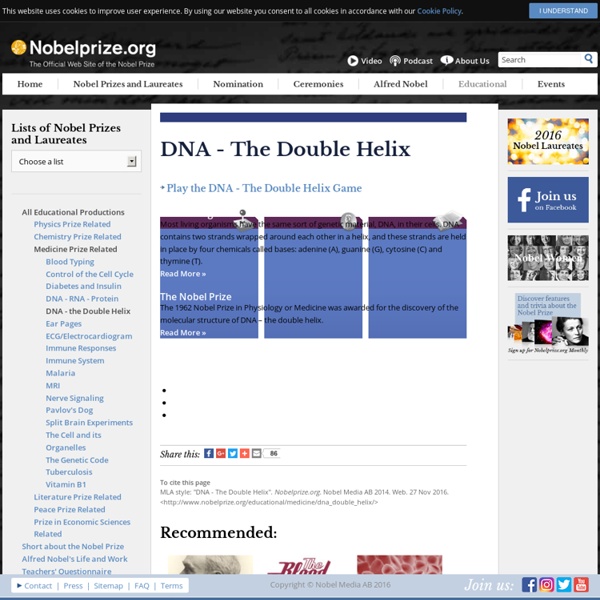The PCR Method - a DNA Copying Machine
Lists of Nobel Prizes and Laureates The PCR Method - a DNA Copying Machine Play the Eye of the Donkey Game About the game
PCR
Primers are short pieces of DNA that are made in a laboratory. Since they're custom built, primers can have any sequence of nucleotides you'd like. In a PCR experiment, two primers are designed to match to the segment of DNA you want to copy.
The Cell and its Organelles
Lists of Nobel Prizes and Laureates The Cell and its Organelles Play the Incredible Megacell Game About the game
Gene Delivery: Tools of the Trade
Genes can be delivered into a group of cells in a patient's body in two ways. The first, called in vivo (in VEE-voh), is to inject the vector directly into the patient, aiming to target the affected cells. The second, called ex vivo (ex VEE-voh), is to deliver the gene to cells that have been removed from the body and are growing in culture. After the gene is delivered, integration and activation are confirmed, and the cells are put back into the patient. Ex vivo approaches are less likely to trigger an immune response, because no viruses are put into patients. They also allow researchers to make sure the cells are functioning properly before they're put in the patient.
Reflections
I quite like making posters (graphorisms, if you will), to collect up ideas from readings, articles, science and the like. I find orgnising the thoughts into something visual and attractive helps clarify them for myself and they add a splash fo colour to otherwise texty blogposts. I often attach them to tweets, and these tend to generate more interaction that text links alone. I usually use the Creative Commons search to find suitably-licensed Flickr images (if I don’t have my own). I edit them in GoogleSlides, using a partly-transparent text box at the bottom for citations and the ColorZilla Chrome colour picker add-on to match the colour palette.
The Split Brain Experiments
Lists of Nobel Prizes and Laureates The Split Brain Experiments Play the Split Brain Experiments
Evolution Extension: Hominoid Drawings
The seven drawings available for downloading from this site, in PDF format, were drawn by Ryan Scott McCullar*, for Martin Nickels at Illinois State University. Each one is a full scale profile, identified, and with a metric ruler for convenience (and to confirm the scale). If you can use a laser printer (e.g. at your district office, school, or local library), your results should be of very good quality, although inkjet printouts should be quite usable. A fast internet connection would also facilitate your downloading success. Each drawing requires about 100K of memory, so, in order to speed up the download time, they are available separately, and must be downloaded as seven separate items.
Pavlov's Dog
Lists of Nobel Prizes and Laureates Pavlov's Dog Play the Pavlov's Dog Game About the game Conditioned reflexes are reflexes you can learn compared to unconditioned reflexes that are built-in, or natural.
Donald Clark Plan B
“The invention of printing, though ingenious, compared with the invention of letters is no great matter” said Thomas Hobbes. He was right, as the invention of the writing is the big bang of learning technology as it led to a still expanding universe of knowledge. Writing allows us to transcend memory. We create and store written content and others can distribute, retrieve, access, read, communicate and search other people’s stored creations through this medium.
Nerve Signaling
Lists of Nobel Prizes and Laureates Nerve Signaling Play the Nerve Signaling Game About
MRI
Lists of Nobel Prizes and Laureates Play MRI the Magnetic Miracle Game About the game In the MRI imaging technique, strong magnets and radio waves are used for getting images of inner organs made of soft tissue, compared to X-ray imaging where you get images of hard tissue, like bones and teeth. Read More »
Escherichia coli long-term evolution experiment
The 12 evolving E. coli populations on June 25, 2008 The E. coli long-term evolution experiment is an ongoing study in experimental evolution led by Richard Lenski that has been tracking genetic changes in 12 initially identical populations of asexual Escherichia coli bacteria since 24 February 1988.[1] The populations reached the milestone of 50,000 generations in February 2010[update]. Since the experiment's inception, Lenski and his colleagues have reported a wide array of genetic changes; some evolutionary adaptations have occurred in all 12 populations, while others have only appeared in one or a few populations. One particularly striking adaption was the evolution of a strain of E. coli that was able to use citric acid as a carbon source in an aerobic environment.[2] Experimental approach[edit] Methods[edit]
The Ear Pages
Lists of Nobel Prizes and Laureates The Ear Pages Play the Ear Pages Game



